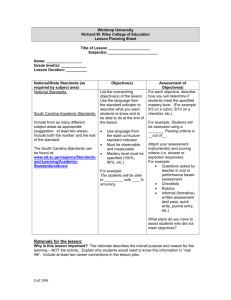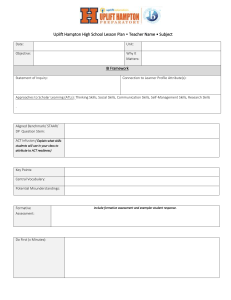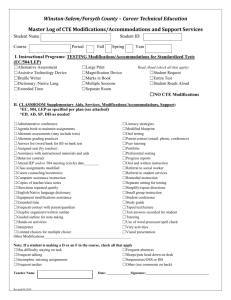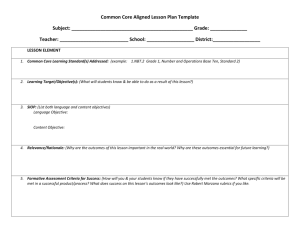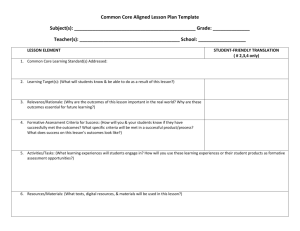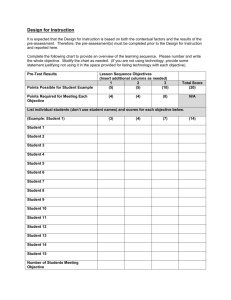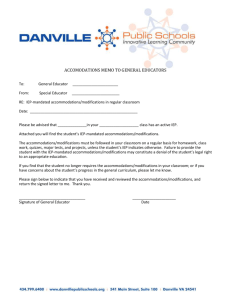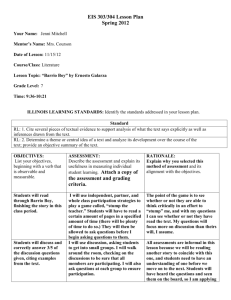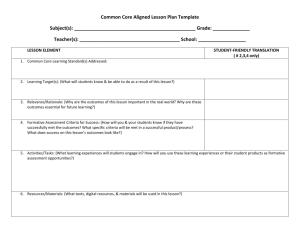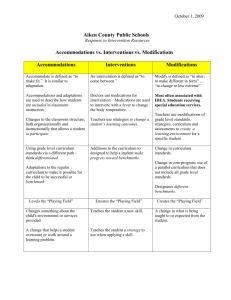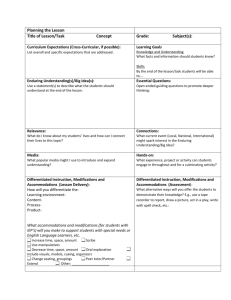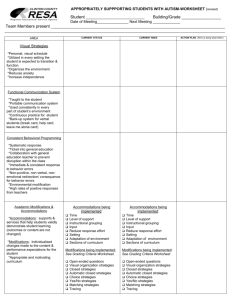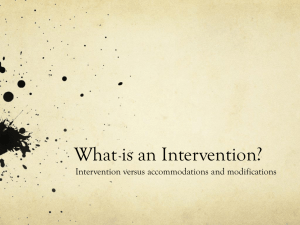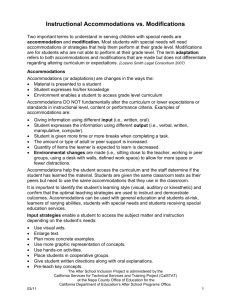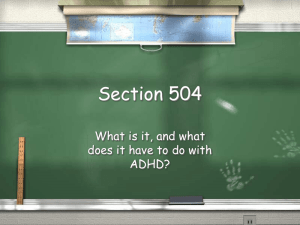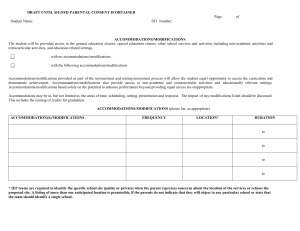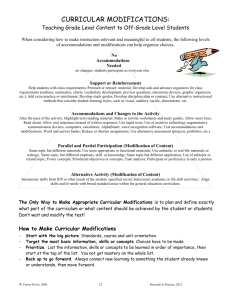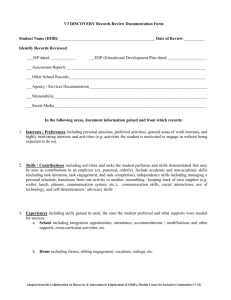Appendix D - Sample Lesson Plan Template
advertisement
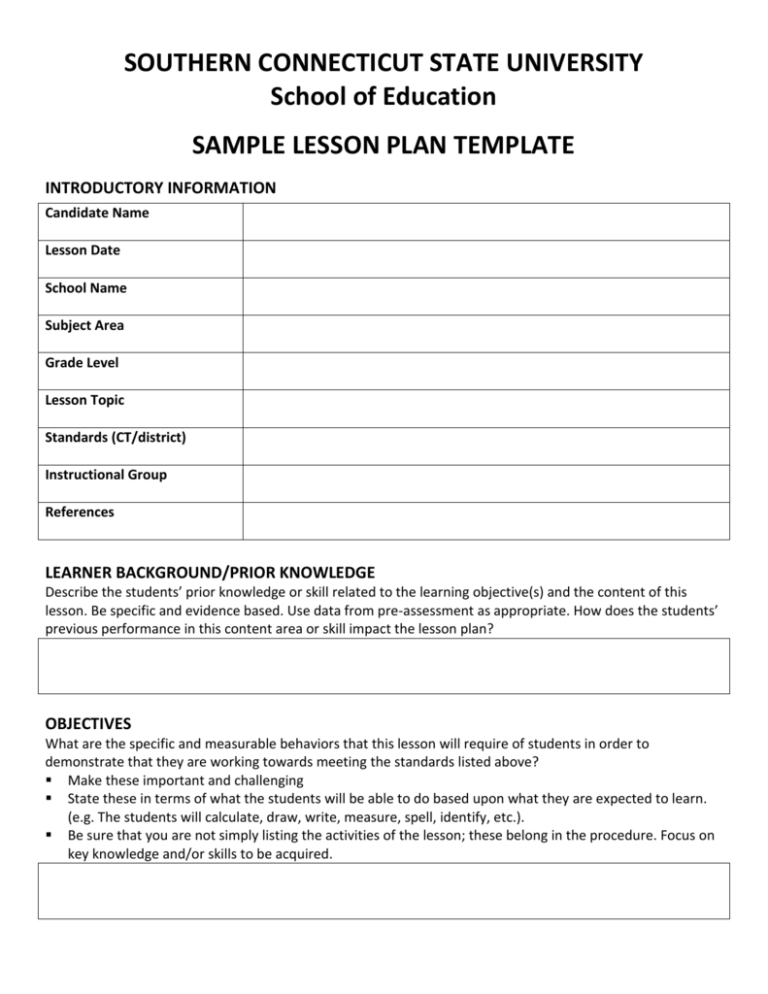
SOUTHERN CONNECTICUT STATE UNIVERSITY School of Education SAMPLE LESSON PLAN TEMPLATE INTRODUCTORY INFORMATION Candidate Name Lesson Date School Name Subject Area Grade Level Lesson Topic Standards (CT/district) Instructional Group References LEARNER BACKGROUND/PRIOR KNOWLEDGE Describe the students’ prior knowledge or skill related to the learning objective(s) and the content of this lesson. Be specific and evidence based. Use data from pre-assessment as appropriate. How does the students’ previous performance in this content area or skill impact the lesson plan? OBJECTIVES What are the specific and measurable behaviors that this lesson will require of students in order to demonstrate that they are working towards meeting the standards listed above? Make these important and challenging State these in terms of what the students will be able to do based upon what they are expected to learn. (e.g. The students will calculate, draw, write, measure, spell, identify, etc.). Be sure that you are not simply listing the activities of the lesson; these belong in the procedure. Focus on key knowledge and/or skills to be acquired. MATERIALS What materials will you use to support your instruction? Over the course of your lessons, these may include workbook and/or textbook materials but should also include original materials developed by you. The types of materials used should be varied over the series of lessons. Include any technology that you plan to use. PROCEDURE How will you start the lesson? The initiation generates students’ interest in the lesson and helps students to understand the purpose of the lesson and what they will be doing. You might: State the objectives of the lesson Connect what students are about to learn in this lesson to what they already know Ask a question or engage the students in a quick activity to motivate interest Relate the lesson to real life LESSON DEVELOPMENT How will you develop the lesson? Assure the content you are teaching is accurate and worthwhile List the steps you will follow during the course of the lesson to ensure that your students reach the objective(s) Logically sequence the steps to help your students reach the objectives Describe the modeling or guidance you will provide Include learning activities that are engaging to students, are culturally responsive, and are appropriate to the content Write sample questions to pose to the students. Be sure to include higher level questions that promote critical thinking Include some expected student responses to your questions CLOSURE How will you connect the various parts of elements of the lesson to “bring it all together” for the students so that they fully understand the purpose of the lesson? You might: Summarize what the students have learned during the course of the lesson or ask the students to summarize what they’ve learned Review one more example of what has been learned as a type of summary Link the lessons to previous learning experiences and explain how it relates to upcoming learning experiences ASSESSMENT How will you determine whether your students have reached the objective(s)? What will they say or do to demonstrate mastery of the objective(s)? What evidence will you collect? Under what conditions will the assessment to be completed? What degree of accuracy or level of mastery do you expect? Assessment should be ongoing throughout the course of the lesson. You may also assess students’ learning at the end of the lesson. Assessments can include discussions with students, paper-and-pencil tasks, or performance-based activities Be sure to take into account the developmental level of your students Attach a copy of any assessment that you use, as well as criteria for evaluating the assessment. If you are assessing through class discussion include a chart or graph of responses. Attach 3 student work samples. ACCOMIDATIONS/MODIFICATIONS/DIFFERENTIATION (Use as Needed) Accommodations: Modifications: What supports are needed to insure access to the content or instruction How would you modify the content process or product to align with the students’ skill acquisition abilities STUDENT 1 Student Name Student’s Instructional Need Accommodations and/or modifications you will make STUDENT 2 Student Name Student’s Instructional Need Accommodations and/or modifications you will make STUDENT 3 Student Name Student’s Instructional Need Accommodations and/or modifications you will make REFLECTIONS What are your reflections on the teaching and learning that has taken place during the lesson? After you have taught the lesson, write some brief notes. You will later incorporate aspects of this reflection into a more detailed reflection on your entire experience with this project. Review and use data to assist you with this process. Use the following questions as a guide: What aspects of the lesson and particular strategies do you think were most effective and why? Did you make any changes mid-stream in the lesson from your original plan and, if so, why? (e.g. did you decide to break the content into two (2) lessons? Did you need to spend additional time on a specific component of the lesson? If you were to teach this lesson again, what would you do differently and why? How well did your students meet the lesson’s objectives? Reflect on assessment data. How did your assessment help you to reach a conclusion about your students’ learning? What are appropriate next steps to further your students’ learning? Is there a need for additional objective(s)/lesson(s)?
